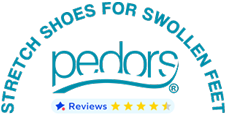Communication and Education and Fall Prevention Guidelines
by Stephen O'Hare, President, Pedors Shoes
A key consideration is to develop effective communication skills to promote fall prevention awareness among individuals, families, caregivers, and healthcare professionals. Here we explore educational approaches and materials for different target audiences.
Individuals
Educational Approaches
• One-on-One Discussions: Engage in personalized conversations with individuals to understand their specific concerns and provide tailored information.
• Workshops and Classes: Group workshops that focus on fall prevention exercises, home safety, and medication management.
• Written Materials: Provide pamphlets, brochures, or booklets that offer tips, checklists, and visual aids for fall prevention.
Communication Skills
• Empathy: Listen actively and empathize with individuals' fears and concerns.
• Clarity: Use plain language and avoid medical jargon to ensure understanding.
• Encouragement: Motivate individuals to take proactive steps toward fall prevention.
• Reiteration: Reinforce key messages and provide written materials for reference.
Families and Caregivers
Educational Approaches
• Family Meetings: Organize family meetings to discuss fall prevention strategies and share responsibilities.
• Caregiver Training: Suggest training sessions on fall risk assessment, home modifications, and proper handling techniques.
• Online Resources: Search for websites or online courses with information and videos on fall prevention.
Communication Skills
• Collaboration: Encourage family involvement and cooperation in fall prevention efforts.
• Clarity and Empathy: Provide clear, empathetic explanations of fall risk factors and prevention strategies.
• Support: Offer emotional support and resources for caregivers dealing with loved ones at risk of falling.
• Active Listening: Listen to caregivers' concerns and experiences, and address any questions or doubts.
Healthcare Professionals
Educational Approaches
• Continuing Education: Offer continuing education courses and workshops on fall risk assessment, evidence-based interventions, and best practices.
• Interdisciplinary Meetings: Conduct interdisciplinary meetings to discuss fall prevention strategies for specific patients.
• Webinars and Conferences: Organize webinars and conferences to share research findings and innovative approaches to fall prevention.
Communication Skills
• Interdisciplinary Communication: Encourage open communication and collaboration among healthcare team members.
• Evidence-Based Education: Promote the use of evidence-based guidelines and research in fall prevention.
• Empowerment: Empower healthcare professionals with the knowledge and tools to educate patients and families effectively.
• Active Engagement: Engage healthcare professionals in discussions and activities that enhance their understanding of fall prevention.
Educational Materials
Educational Approaches
• Brochures and Flyers: Create visually appealing brochures and flyers with practical tips and checklists.
• Videos: Develop instructional videos demonstrating fall prevention exercises, home safety measures, and medication management.
• Mobile Apps: Design interactive apps that provide fall risk assessments, exercise routines, and safety checklists.
• Websites: Establish dedicated websites with comprehensive information, resources, and links to relevant organizations.
• Social Media: Use social media platforms to share informative articles, infographics, and success stories.
Communication Skills
• Visual Clarity: Ensure that educational materials are visually appealing and easy to understand.
• Accessibility: Make materials available in various formats, such as print, digital, and audio, to accommodate different learning preferences.
• Consistency: Maintain a consistent message across all educational materials and platforms.
• Feedback Mechanisms: Encourage feedback and questions from users to improve the effectiveness of materials.
Conclusion
Tailoring communication strategies and educational materials to the specific needs and preferences of each target audience is essential for promoting fall prevention awareness effectively. Additionally, involving individuals, families, caregivers, and healthcare professionals in the development and dissemination of materials can enhance their relevance and impact.


